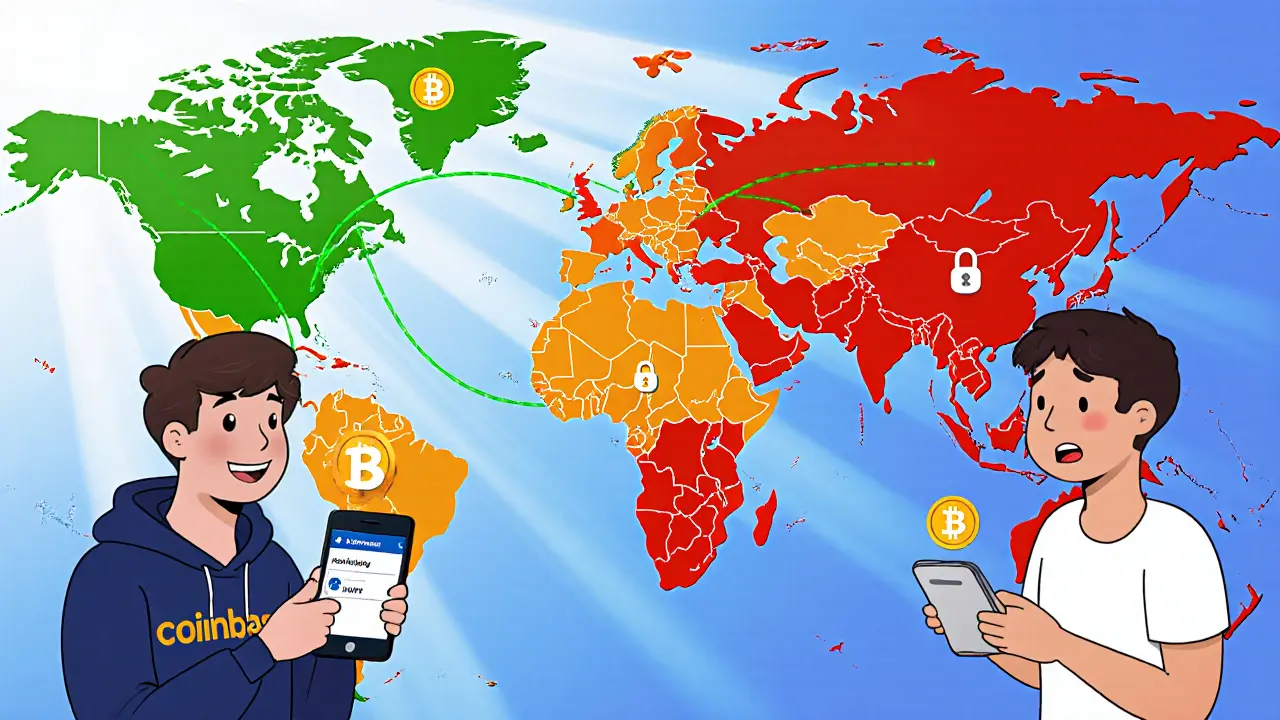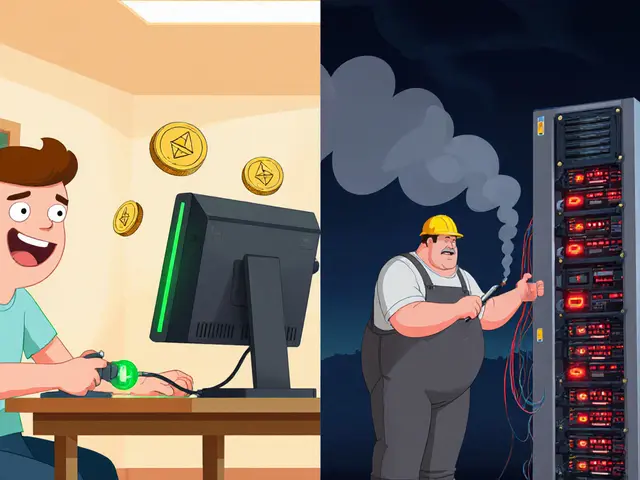Coinbase Geographic Crypto Restrictions by Country: What’s Allowed and What’s Blocked

If you're trying to use Coinbase to buy or sell crypto with real money and you're getting blocked, you're not alone. Thousands of users around the world hit the same wall: Coinbase says their service isn't available in their country-even if they have a valid ID, a bank account, and a clear understanding of how crypto works. This isn't a glitch. It's by design. And the reason isn't just technical-it's legal, political, and deeply tied to how governments and regulators treat cryptocurrency.
Why Coinbase Blocks Countries
Coinbase doesn't pick which countries to serve based on demand or popularity. It picks based on risk. The company is registered in the United States and must follow U.S. laws, especially those from the Office of Foreign Assets Control (OFAC). OFAC maintains a list of sanctioned countries and individuals-places like Russia, Iran, North Korea, Syria, Cuba, and Crimea. If you're in one of those places, Coinbase legally can't let you deposit dollars, euros, or any other fiat currency. Even if you're just visiting, your IP address triggers the block. But it's not just about sanctions. Some countries have their own crypto bans or heavy restrictions. In 2024, Nigeria and Egypt joined the list of places where Coinbase shuts down access entirely. Why? Because local regulators threatened legal action if Coinbase operated without a license-and getting one isn't always possible. Unlike Binance or Kraken, Coinbase plays it safe. They'd rather lose users than risk fines, lawsuits, or losing their U.S. banking partners.What You Can and Can't Do: Coinbase App vs. Coinbase Wallet
This is where things get confusing. There are two different products from Coinbase, and they work completely differently. The Coinbase App is the one you use to buy crypto with a bank transfer, credit card, or Apple Pay. It's the full-service exchange. You need to verify your identity, link your bank, and wait for approvals. This app is only available in 48 countries-including the U.S., U.K., Germany, France, Canada, Australia, and Singapore. If you're in one of those, you can deposit up to $50,000 a day after full verification. Then there's Coinbase Wallet. This is a self-custody wallet-like MetaMask, but with a cleaner interface. It doesn't let you buy crypto with fiat. But it does let you store, send, and interact with decentralized apps (dApps) on Ethereum and other blockchains. And here's the key: Coinbase Wallet works in almost every country in the world-except those under OFAC sanctions. So if you're in Pakistan, the Philippines, or Colombia, you can't use the App to buy crypto. But you can still install the Wallet and connect it to decentralized exchanges like Uniswap or Curve. That’s a huge gap. In places like the Philippines, where 83% of crypto users need to convert pesos to crypto, Coinbase Wallet is useless for buying. Users are forced to use local exchanges like PDAX, which charge 3.5% per trade-seven times more than Coinbase’s 0.5% fee.Where Coinbase Works (Fiat Access)
If you're in one of the 48 supported countries, you get full access. That includes:- United States and Canada
- All 27 EU member states (thanks to MiCA compliance)
- United Kingdom
- Australia, New Zealand
- Japan, Singapore, South Korea
- Switzerland, Norway, Iceland

Where Coinbase Doesn’t Work (And Why)
Here’s the reality: over 150 countries are either fully blocked or have partial access. The biggest groups are:- OFAC-sanctioned countries: Russia, Iran, North Korea, Syria, Cuba, Crimea
- Crypto-banned countries: Nigeria, Egypt, Algeria, Bangladesh
- High-risk, low-compliance countries: Pakistan, Philippines, Colombia, Kenya
How Coinbase Knows Where You Are
Coinbase doesn’t guess. It uses three layers to lock you out:- IP geolocation: Your device’s public IP address tells them where you’re connecting from. Even if you're traveling, your IP might still show your home country.
- KYC documents: When you upload your ID, it’s scanned for location data. A U.S. driver’s license from Texas won’t work if your IP says you’re in Brazil.
- Bank account verification: If you link a U.S. bank account but log in from India, your account gets flagged.
What About the UAE, India, and Other Gray Areas?
Some countries sit in the middle. The UAE is a good example. Coinbase doesn’t let you deposit via bank transfer. But you can use Apple Pay. Why? Because Apple Pay is tied to your credit card, not your bank. And the UAE doesn’t regulate crypto payments the same way it regulates banks. India is another gray zone. Coinbase used to block users entirely. In early 2025, they tried to register with the Reserve Bank of India (RBI). That effort failed. So they’re back to blocking. But users report mixed results-some can log in, others can’t. There’s no official update. This inconsistency frustrates users. One Reddit thread from March 2025 had over 200 comments from users in the same country getting different results. There’s no clear pattern. It’s not based on income, age, or device. It’s based on backend compliance flags that Coinbase doesn’t disclose.
What You Can Do If You’re Blocked
If you’re in a restricted country, here’s what actually works:- Use Coinbase Wallet: Download it from the App Store or Google Play. It works almost everywhere except sanctioned countries.
- Connect to a DEX: Use Wallet to link to Uniswap, PancakeSwap, or Curve. Buy crypto with stablecoins you already own.
- Use local exchanges: In the Philippines, use PDAX. In Pakistan, use Binance P2P. In Nigeria, use NairaEx. They may charge more, but they’re legal and fast.
- Don’t use a VPN: It will get your account banned. Coinbase has a zero-tolerance policy.
What’s Changing in 2025
Coinbase is under pressure from regulators everywhere. The SEC lawsuit (filed in June 2023) is still ongoing. If Coinbase loses, they may have to shut down even more services in Europe and Asia. MiCA, the EU’s new crypto law, forced Coinbase to restructure its European operations. As of August 2025, users in Malta, Iceland, Liechtenstein, and Hungary now deal with Coinbase Luxembourg S.A. instead of Coinbase Europe Limited. India’s situation remains uncertain. If the RBI approves registration in late 2025, Coinbase might return. But that’s a big if. Meanwhile, the number of countries where crypto is fully banned has grown to 34. More are expected to follow. Coinbase’s market share in compliant regions is strong-56% in the U.S., 21% globally-but their total addressable market is shrinking.Bottom Line: It’s Not About Technology, It’s About Law
Coinbase isn’t blocking countries because they’re too hard to serve. They’re blocking them because serving them could cost millions in fines-or even shut down their entire business. The company’s priority is compliance, not accessibility. If you’re in a supported country, you get one of the easiest, safest ways to buy crypto. If you’re not, you’re left with alternatives that are less regulated, more expensive, and riskier. That’s the reality of crypto in 2025: it’s not a global currency. It’s a patchwork of legal zones, each with its own rules. Don’t waste time trying to bypass the system. Understand your country’s status. Use the tools that work. And if you need fiat access, find a local exchange that’s licensed where you live. It’s not ideal-but it’s the only way that doesn’t risk your account, your money, or your access forever.Why can’t I use Coinbase in my country even though I have a valid ID?
Coinbase doesn’t just check your ID-it checks where you live, where you’re connecting from, and which bank you’re using. Even with a valid ID, if your IP address, bank account, or phone number is linked to a restricted country, you’ll be blocked. This is required by U.S. law (OFAC sanctions) and local regulations. Your ID proves who you are, but not where you’re allowed to use the service.
Can I use Coinbase Wallet in a country where the App is blocked?
Yes. Coinbase Wallet is a non-custodial wallet and doesn’t offer fiat on-ramps, so it’s not subject to the same restrictions. You can download it and use it in almost every country except those under U.S. sanctions (like Russia or Iran). But remember: you can’t buy crypto with real money using Wallet. You’ll need to transfer crypto from another exchange or wallet first.
Is using a VPN to access Coinbase safe?
No. Coinbase actively detects and bans users who use VPNs to bypass geo-restrictions. Accounts caught doing this are often frozen permanently, and funds may be locked indefinitely. There is no appeal process. The risk isn’t worth it-especially since local exchanges exist in most restricted countries.
Why does Coinbase work in Germany but not in the Philippines?
Germany has clear, friendly crypto regulations under MiCA and full licensing from BaFin. The Philippines doesn’t have a clear regulatory framework for foreign exchanges, and Coinbase hasn’t partnered with local banks there. Even though crypto use is high in the Philippines, Coinbase doesn’t have the legal infrastructure to offer fiat deposits. Binance and PDAX fill that gap because they’re either local or have local partnerships.
Will Coinbase ever expand to more countries?
Possibly-but slowly. Coinbase only expands into countries with strong legal frameworks, banking partnerships, and low risk of regulatory backlash. They’re unlikely to enter countries like Nigeria, Pakistan, or Bangladesh unless those governments create clear, stable rules for foreign exchanges. For now, expansion is focused on tightening compliance in existing markets, not opening new ones.
What’s the difference between Coinbase and Binance in terms of country access?
Binance offers fiat access in more countries than Coinbase-around 70+ compared to Coinbase’s 48. Binance also supports local currencies like Pakistani rupees and Nigerian naira via P2P trading. But Binance has faced legal trouble in the U.S. and EU, while Coinbase is fully licensed in the U.S. and compliant with MiCA in Europe. Coinbase is safer for U.S. and EU users. Binance is more accessible globally but riskier legally.
Why is Cardano staking blocked in some EU countries?
Under MiCA’s transitional rules, staking services are classified as financial products and require extra licensing. Coinbase hasn’t applied for staking licenses in 12 EU countries yet, so they’ve disabled the feature there to stay compliant. This is temporary, but there’s no timeline for when it will return. It’s not about the asset-it’s about the regulatory process.



Write a comment